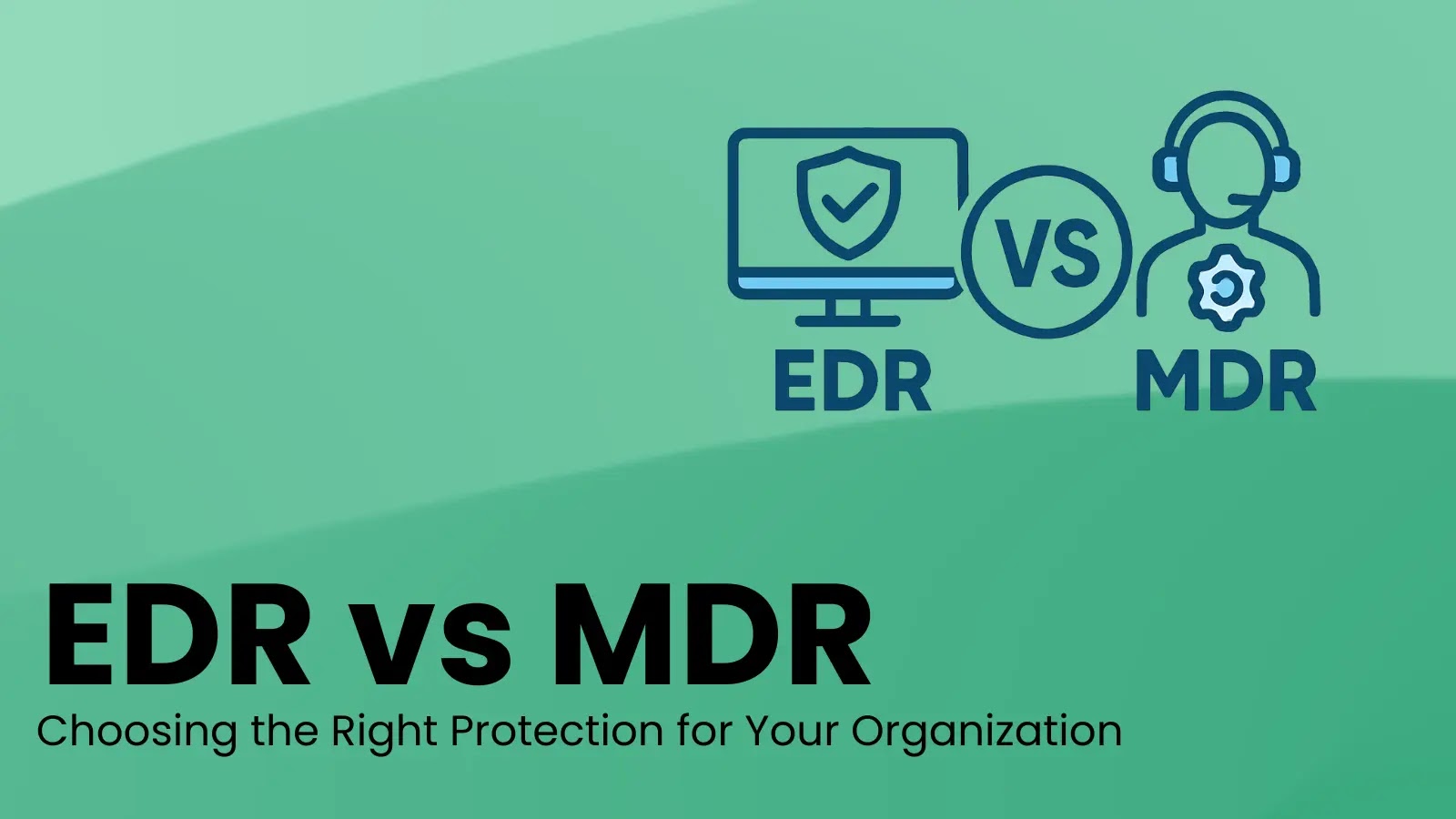
EDR vs MDR – What is the Difference and Which Solution Right for Your Organization?
Navigating the Cybersecurity Landscape: EDR vs. MDR
As cybersecurity threats relentlessly increase in complexity and sophistication, organizations face critical decisions regarding their security infrastructure. Two prominent and highly effective approaches have emerged as frontrunners in enterprise security: Endpoint Detection and Response (EDR) and Managed Detection and Response (MDR). While both solutions aim to protect organizations from advanced threats, they differ significantly in their implementation, management requirements, and scope. Understanding these nuances is crucial for determining which solution, or combination thereof, best fits your organization’s unique security posture and operational capabilities.
Understanding Endpoint Detection and Response (EDR)
Endpoint Detection and Response (EDR) is a cybersecurity solution that continuously monitors and collects data from endpoint devices such as laptops, desktops, servers, and mobile devices. Its primary purpose is to detect malicious activity, investigate security incidents, and respond to threats at the endpoint level. EDR tools provide deep visibility into endpoint activities, including process execution, file changes, network connections, and user behavior. This granular data allows security teams to identify suspicious patterns that might indicate an attack, even those that bypass traditional antivirus solutions.
- Key Capabilities:
- Real-time Monitoring: Constant surveillance of all endpoint activity.
- Threat Detection: Utilizes behavioral analytics, machine learning, and threat intelligence to identify known and unknown threats.
- Incident Investigation: Provides rich telemetry data for detailed forensic analysis of security incidents.
- Automated Response: Can isolate infected endpoints, kill malicious processes, and roll back system changes.
- Vulnerability Insight: Helps identify potential weak points on endpoints that attackers might exploit, though it’s not a dedicated vulnerability scanner. For instance, an EDR might flag unusual activity leading to a potential exploitation of CVE-2023-38827.
- Management: EDR solutions are typically managed by an organization’s internal security team. This requires dedicated security analysts with the expertise to configure the solution, interpret alerts, conduct investigations, and execute response actions. While EDR provides powerful tools, its effectiveness heavily relies on the skill and availability of the in-house security team.
Understanding Managed Detection and Response (MDR)
Managed Detection and Response (MDR) is a service that combines technology with human expertise to deliver 24/7 threat monitoring, detection, and response. Unlike EDR, which is a tool an organization uses, MDR is a complete managed service typically provided by a third-party security firm. MDR providers leverage their own security information and event management (SIEM), EDR technologies, and other security tools, along with a team of seasoned security analysts, to monitor an organization’s environment for threats.
- Key Capabilities:
- 24/7 Monitoring & Alerting: Constant vigilance by human experts.
- Advanced Threat Hunting: Proactive searching for hidden threats that might evade automated defenses.
- Incident Validation & Prioritization: Reduces alert fatigue by validating and prioritizing true positives.
- Guided & Full Incident Response: Provides actionable advice or directly executes response actions, such as isolating compromised systems potentially impacted by a zero-day exploit like CVE-2023-28252.
- Threat Intelligence Integration: Utilizes up-to-the-minute global threat intelligence.
- Security Expertise & Staff Augmentation: Provides access to security professionals without the overhead of hiring an in-house team.
- Management: With MDR, the heavy lifting of security operations is outsourced. The MDR provider handles the deployment, configuration, monitoring, analysis, and response, effectively acting as an extension of your security team. This model is particularly appealing to organizations that lack the resources, expertise, or desire to build and maintain a sophisticated in-house security operations center (SOC).
EDR vs. MDR: Key Differences and Considerations
The fundamental distinction between EDR and MDR lies in their operational model and the level of management required from the client organization. EDR is a powerful technology that empowers an internal security team, while MDR is a comprehensive service that delivers security outcomes by combining technology with expert human oversight.
| Feature | Endpoint Detection and Response (EDR) | Managed Detection and Response (MDR) |
|---|---|---|
| Type of Offering | Technology/Software Tool | Managed Service (Technology + Human Expertise) |
| Management Model | Managed by internal security team | Managed by third-party provider |
| Required Internal Expertise | High (dedicated security analysts/engineers) | Low to Moderate (requires coordination with provider) |
| Scope of Coverage | Primarily endpoints, deep visibility | Broader, often includes network, cloud, identity, and endpoints |
| 24/7 Monitoring | Requires internal staffing or automation | Included as part of the service |
| Threat Hunting | Requires internal execution | Provided proactively by service |
| Incident Response | Internal team executes based on EDR data | Provider offers guided or full response |
| Typical User | Organizations with mature security teams and SOCs | Organizations lacking dedicated SOC, limited resources, or seeking rapid maturity |
Choosing the Right Solution for Your Organization
The decision between EDR and MDR, or even a hybrid approach, hinges on several critical factors pertinent to your organization’s specific circumstances:
- Internal Security Resources & Expertise: Do you have a dedicated, skilled security team capable of monitoring, analyzing, and responding to security incidents 24/7? If not, MDR offers a practical solution to bridge this gap.
- Budget: While MDR typically involves a higher recurring service fee, it can be more cost-effective than building and maintaining an in-house SOC, which includes salaries, training, and technology investments. EDR’s costs are primarily licensing and the significant internal labor required.
- Compliance Requirements: Certain regulations may necessitate 24/7 monitoring and rapid incident response capabilities. MDR can help organizations meet these stringent requirements efficiently.
- Risk Appetite & Threat Landscape: Organizations in high-risk industries or those frequently targeted by sophisticated attacks may find the proactive threat hunting and rapid response of MDR invaluable.
- Security Maturity: For organizations just beginning to mature their security posture, MDR can rapidly elevate their defensive capabilities without a lengthy internal build-out. More mature organizations might leverage EDR to enhance their existing processes.
Remediation Actions and Strategic Choices
It’s important to view EDR and MDR as complementary, rather than mutually exclusive, components of a robust cybersecurity strategy. Many MDR providers actually integrate leading EDR technologies into their service offering, providing the best of both worlds: powerful endpoint visibility coupled with expert human analysis and response.
- If choosing EDR:
- Invest in continuous training for your security team on EDR tool capabilities, threat analysis, and incident response procedures.
- Establish clear playbooks for alert triage and response.
- Consider staffing an internal 24/7 SOC, or at least a highly responsive on-call rotation.
- Regularly review EDR policies and configurations to adapt to evolving threats.
- If choosing MDR:
- Thoroughly vet potential MDR providers. Look for strong SLAs, transparent reporting, and deep experience in your industry.
- Establish clear lines of communication and collaboration protocols with your chosen MDR partner.
- Understand the scope of their service, especially regarding full incident response vs. guided response.
- Despite outsourcing detection and response, maintain strong internal security hygiene, patch management, and user awareness programs.
- For Hybrid Approaches: Some organizations manage their EDR during business hours and hand over monitoring and response to an MDR provider during off-hours, optimizing internal resources while maintaining 24/7 coverage.
Conclusion
Both EDR and MDR are indispensable components in the contemporary fight against cyber threats. EDR empowers organizations with deep visibility and control over their endpoints, contingent on internal expertise. MDR, conversely, provides a comprehensive, expert-driven service that delivers continuous threat detection, hunting, and response without the burden of building and maintaining a full-scale security operations center. The optimal choice depends on a candid assessment of your organization’s internal capabilities, security objectives, budgetary constraints, and overall risk tolerance. Whichever path you choose, bolstering your defenses with advanced detection and response capabilities is no longer optional—it’s a fundamental requirement for business resilience.





